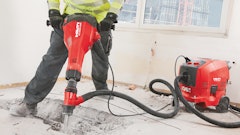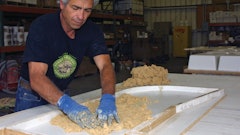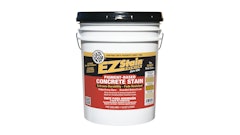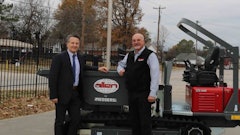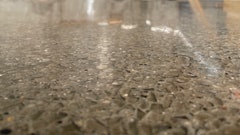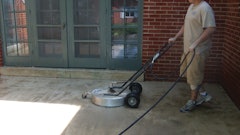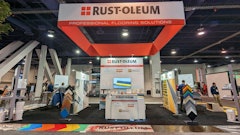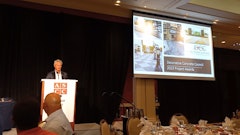There are many decorative treatments for freshly placed concrete, including pattern stamping, exposed aggregate and textured finishes. But what about an existing plain, gray concrete driveway, sidewalk or patio that’s in sore need of decorative flair? How do you give it a dramatic and lasting makeover, short of ripping it out and starting over?
One answer is engraving — the use of special tools and equipment to cut patterns and designs into existing concrete. Unlike toppings or overlays, engraving is a permanent treatment that won’t wear away or lose bond because the patterns are carved into the concrete rather than applied on top of it. When the concrete is further enhanced by staining, the decorative possibilities are truly spectacular.
The best news is that you don’t have to be a skilled artist to engrave intricate designs in concrete. Two patented systems, Engrave-A-Crete and KaleidoCrete, arm you with all the tools you need to cut an endless array of patterns and designs and achieve professional results every time. Both systems were developed by Darrel Adamson, who manufactures and distributes them to decorative concrete contractors worldwide through his company Engrave-A-Crete, based in Bradenton, Florida. He also helps contractors master the engraving process by conducting hands-on training sessions.
Adamson’s former experience, first as a remodeling contractor specializing in commercial concrete sawing and drilling and later as a decorative concrete contractor, inspired the idea for a machine that could cut patterns in concrete. In the early 1990s, he introduced his first engraving machine to the market, and over the past decade, his equipment and methods for decorative concrete engraving have continued to evolve.
“What is unique about all of our tools is that they are able to cut circles,” he says. “They also can cut straight lines and curves, so patterns of any shape are possible, from a simple circle or rectangle to intricate graphic designs.”
The Engrave-A-Crete and KaleidoCrete systems can be used alone or in combination. Many contractors use both systems to broaden their design repertoire.
The Engrave-A-Crete System
The Engrave-A-Crete system allows you to cut linear or circular brick, cobblestone or tile patterns in concrete surfaces. Designed to cover fairly large areas, a walk-behind engraving machine, guided by a tracking system, cuts repetitive patterns quickly and accurately.
For circular patterns, the machine rotates around a center pivot point like a compass, with a connecting bar guiding machine movement. You also can use multiple pivots to weave two or more circular patterns together. Multi-position tracking rails, available in different lengths, guide straight cuts, such as brick head joints.
Specially designed diamond blades make the cuts. “Our blades are made specifically for our tools,” Adamson says. “They make shallow cuts continuously using relatively low-horsepower equipment.” The blades also come in several different widths, ranging from 1/8 to 1 inch, so you can vary the width of the simulated grout line.
Since the first Engrave-A-Crete system was introduced in 1990, the equipment has undergone several modifications to improve maneuverability and the precision of the cutting action. The latest model, the Super-Compact 2500-D, is lightweight (at just over 40 pounds) and can achieve 99-percent cutting accuracy, Adamson says. A 6,000-rpm, 60-cycle electric motor powers the machine. Continuous depth control, provided by a contour-following wheel, keeps the cutting depth consistent on uneven surfaces. “The depth of decorative cuts has to remain close to accurate; it can’t go up and down, or you’ll notice it,” Adamson says.
A smaller concrete engraving tool, called the Mongoose, can perform engraving work in small or restricted areas, such as close to walls or on steps, where it’s hard for the larger Super-Compact to maneuver. The Mongoose has a powerful 11,000-rpm, 9-amp motor and front and rear cutting guides so it can follow a chalk line easily. When equipped with an optional center pivot, it also can cut perfect circles.
The KaleidoCrete System
The KaleidoCrete system can cut intricate or custom designs into concrete. It uses hand-held percussive engraving tools guided by templates, which are available in thousands of patterns and designs, including letters, logos, borders and custom graphics. The tools also can be used freehand.
The main component of the KaleidoCrete system is the Shark Concrete Engraver, a compact air-powered tool weighing less than 12 pounds. Its driver measures just over an inch in diameter and has 64 impactor teeth that eat into the concrete to produce a crisp cut up to 1/4 inch deep.
“With the Shark, the operator controls precision and depth of cut,” Adamson says. “It depends on the amount of air pressure running to the tool, the sharpness of the teeth and how long you hold the tool in one spot.”
Another tool, called the Wasp, is handy for doing touch-up work after the Shark and for adding fine details. It uses a single reciprocating carbide stylus cutter, called a Stinger. “Sometimes the edges may not be completely finished after you run a Shark around them,” Adamson says. “You can take the Wasp and make the edges nice and crisp,” He adds that some users call it a “concrete pencil” because it can be operated freehand to engrave letters and names in the concrete.
Hands-on Training Available
Engrave-A-Crete holds training sessions once a month at its facility in Bradenton, Florida. Attendees receive hands-on training in the use of each tool and learn techniques for laying out and cutting the patterns. Training in staining techniques also is offered, covering everything from surface prep before staining to achieving intricate multicolor patterns.
Although machine owners aren’t required to attend the Engrave-A-Crete training sessions, Adamson highly recommends it, saying that the training gives participants enough confidence and skill to start doing professional installations right away. “We think everyone’s first job after attending the training can be a paying job, rather than a practice job.”
Anne Balogh is a writer for ConcreteNetwork.com (www.concretenetwork.com), a Web site serving more than 400,000 visitors per month seeking information on concrete industry products and concrete contractor service providers.





